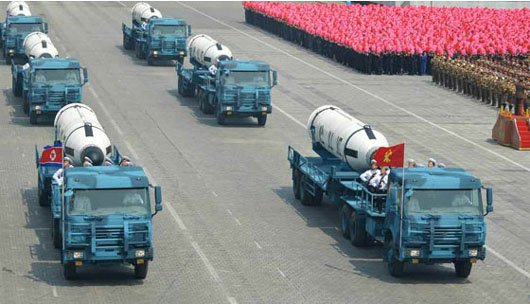by WorldTribune Staff, April 18, 2022
It has been known, and reported almost exclusively by independent media, that for the last ten years China has provided material and technical support that North Korea needs to launch a nuclear attack on the United States.
April 15 marked “a decade of unpunished Chinese Communist Party (CCP) perfidy,” analyst Rick Fisher, a senior fellow at the International Assessment and Strategy Center, wrote for The Epoch Times.

It was on April 15, 2012 that it was revealed China had provided large trucks to North Korean to carry its intercontinental ballistic missiles (ICBMs).
“China was abetting North Korea’s ability to vaporize U.S. cities,” wrote Fisher, a Geostrategy-Direct.com contributing editor.
On March 24, 2022, the third generation of the same Chinese truck launched a new, larger North Korean ICBM “which may soon be equipped with multiple nuclear warheads—an unprecedented level of nuclear terror enabled by the CCP,” Fisher wrote. “Their goals include deterring the United States from defending its allies Japan and South Korea, and creating a nuclear crisis to divert U.S. attention if the Chinese regime invades Taiwan.”
Chinese assistance to North Korea’s missile and nuclear missile development has been know for a decade, but not a single U.S. sanction has been imposed on China.
“In fact, starting in 2012, the United States should have been economically and politically isolating the CCP for abetting the creation of yet another nuclear missile terror state,” Fisher wrote.
The lack of American sanctions provided the communist regime in China “another demonstration of weakness that has diminished the American ability to deter aggression by the CCP and North Korea,” Fisher wrote, adding tat China over time “has learned that a timorous and gullible American leadership is of incalculable value as the CCP advances its goals in Asia and globally.”
Fisher had signaled the warning before. A Sept. 19, 2017 report by Geostrategy-Direct.com cited him on how the Chinese Sinotruk vehicles carrying North Korea’s KN-11s demonstrated China’s covert role in assisting Pyongyang’s strategic missile launch systems.
“Let’s be clear, North Korea is able to wage surprise offensive nuclear strikes against the United States only because China has supplied the means for North Korea’s missiles to be mobile, to reach launch positions before the United States can strike them,” Fisher was quoted as saying in the 2017 article.
The United Nations reported in April 2017 that Chinese electronic components were found in debris of a North Korean missile test that landed in the Sea of Japan in 2016.
Last September, North Korea tested a new hypersonic glide vehicle warhead that “looks like China’s Dongfeng-17 hypersonic glide vehicle armed ballistic missile,” Fisher wrote for The Epoch Times.
In January, North Korea tested a precision-guided missile warhead “that looks like the one used by the CASIC Dongfeng-21C medium-range ballistic missile” produced by China. “This warhead is the basis of the anti-ship ballistic missile (ASBM) warhead used on the DF-21D and DF-26B ASBMs,” Fisher added.
Fisher continued: “With appropriate satellite guidance cues that China could supply, North Korea may soon be able to conduct precision nuclear ASBM strikes against U.S. Navy nuclear aircraft carriers.”
Last year, the CCP shut down several Chinese military enthusiast web pages, at least one of which had identified the truck being used to haul North Korea’s ICBMs as being produced in China. The CCP did this, Fisher noted, “to deny even this meager source of intelligence to Western countries that are now the targets of CCP aggression.”
A Sanjiang/CASIC brochure that was posted on one of the sites, which enabled Chinese netizens to correctly identify the “North Korean” TEL as a version of the CASIC/Sanjiang WS2600, a version of the WS51200 TEL that is based on technology purchased from the Minsk Automobile Plant (MAZ) of Belarus.
“What was most important about this revelation was that the CCP — which since 1994 had led the “Six-Party Talks” ostensibly aimed at ending North Korea’s nuclear weapons programs — was committing a new level of evil that it was flaunting before the world,” Fisher wrote.
The Obama administration, Fisher noted, had blatantly refused to call out China.
Rep. Michael Turner, then-chairman of the Strategic Forces Subcommittee of the House Armed Service Committee, on April 19, 2012 queried Secretary of Defense Leon Panetta about possible Chinese missile technology assistance to North Korea.
Panetta said, “I’m sure there’s has been some help coming from China.”
But the next day, on April 20, 2012, The New York Times quoted an unnamed “White House official” offering a shocking cover for China: “We think this is poor Chinese performance in sanctions implementation, and not willful proliferation,” said the [White House] official, who spoke on the condition of anonymity because of the issue’s diplomatic delicacy. “The Chinese system is so sprawling and poorly organized that they are not good at enforcing sanctions.”
Asahi Shimbun then reported: “Japan, the United States, and South Korea had solid evidence to prove that China … had violated a UN Security Council resolution banning weapons exports to North Korea. … But the three countries decided not to pursue the matter in the Security Council. … The chief concern among the three nations was to prevent a third nuclear test by North Korea and alleviate tensions on the Korean Peninsula, and they needed Beijing’s help on that matter.”
About . . . . Intelligence . . . . Membership
